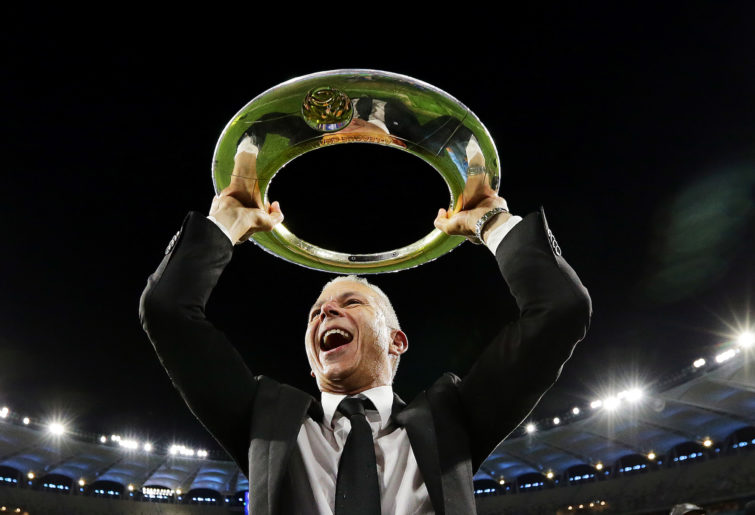Since the start of the A-League in 2005, it’s quite possible Monday’s announcement that the Grand Finals – the showpiece event of both the men’s and women’s competition – would be held in Sydney for the next three years is one of the biggest decisions since its inception.
Over the course of the last 17 years, the Men’s Grand Final has been held in every Australian state capital bar Hobart. Perth attracted the biggest Grand Final crowd when almost 60,000 sold out Optus Stadium in 2019 for the Glory vs Sydney FC.
Melbourne has hosted the decider the most number of times (six), with these split between whatever Docklands Stadium is called this week and AAMI Park. Sydney has staged the Grand Final five times (four times at Allianz, once at the new Parramatta Stadium).
Sydney has also hosted the only “neutral” final, when Central Coast Mariners and Newcastle Jets fans packed out the SFS in 2008, after the FFA deemed the Mariners’ stadium wasn’t big enough for the expected crowd.
Brisbane’s Suncorp Stadium/Lang Park has seen three Grand Finals with the home team winning all of them, always to a full house. Adelaide and the aforementioned Perth have hosted one each, with Newcastle staging the 2018 version, and becoming the first regional city to host a Grand Final in any code.
It was a unique selling point for the football codes in this country – a Grand Final that was in essence a travelling roadshow, and a tremendous carrot to dangle in front of clubs vying for the title. Only five times in 17 years have the “away” side won the Grand Final, and even that comes with a qualification.
In 2008, “home” side Central Coast lost to Newcastle – in Sydney. And in 2013, in their inaugural year, Western Sydney played the Grand Final at the SFS rather than Parramatta, and were beaten by the Mariners. Clearly, hosting the Grand Final was a tremendous advantage and one that rewarded a team’s performances across the whole season.
All that is now a series of moot points. For what has been reported as an eight-figure sum, the NSW Government has secured the hosting rights to the A-Leagues and the Australian Professional Leagues (APL) is bullish in its desire to create a week-long “football festival” in Sydney to establish the competitions as significant dates on the sporting calendar. Significantly, there was no announcement of a host stadium, just the host city.
APL CEO Danny Townsend was naturally spruiking the decision as a win for fans, who could now plan their Grand Final trip months in advance, knowing where the match will be.
This is assuming that fans in Perth are interested in taking a punt on the Glory somehow coming good in the next 16 rounds, or that Roar fans are optimistically foreseeing a return to the Ange-inspired era of Roarcelona, or that Western United fans would love the certainty of knowing where their side would play at all (how is that stadium build at Tarneit going?).

(Photo by Quinn Rooney/Getty Images)
Danny Townsend made comparisons with England’s FA Cup at Wembley and the Stade de France decider in Paris in announcing Sydney’s hosting rights. He also pointed out the logistics of staging Grand Finals in the past few years.
In 2019, a week out from the game, Sydney, Perth or Adelaide could have hosted the event, such was the make-up of the semi-finals. It meant fans only had one week to plan, book flights if necessary and find accommodation.
Similarly, in 2021, the Grand Final venue was a tussle between Sydney, Melbourne and Adelaide six days before it was due to be played.
What the CEO is not saying is that coordinating a Grand Final venue on such short notice is something of an organisational nightmare. Having a secured venue means the ability to promote and highlight the host and the event can happen well in advance. Ticket and accommodation packages can be sold weeks or months before the game. From a marketing perspective, it’s a big win for the APL.
But, really, marketing the A-Leagues has hardly been a significantly successful KPI for whichever organisation has been running the competitions in recent years. Yet, despite, the obvious obstacles, every pre-Covid era Grand Final went close to selling out, no matter how long or short the run-in.

Sydney FC coach Steve Corica (Will Russell/Getty Images)
The majority of those tickets were snapped up by home fans, although the fanatically magnificent fans of Western Sydney Wanderers sure made a dent in the sea of Brisbane orange in 2014, and were present in large numbers to rock the City of Churches in 2016.
What is also not being said is that the A-League had caused their own headaches by changing the format of the finals series. The finals were increased to a six-team playoffs in 2010. Prior to that it was a top four, but the principle remained the same. The top two would meet in a home-and-away two-legged playoff and the winner would advance to, and host, the Grand Final.
This meant that from the moment the home-and-away series concluded and a Premier’s Plate winner was confirmed, organisers knew that there were only two possible Grand Final venues, a month away from the game happening. However, in 2013, the league moved away from the established format, and instead granted the top two a week off in the first week of the finals.
This reduced the finals series to three weeks and meant every game was a knockout match. It also meant that a grand final venue would be never confirmed until a week before the game, and, as cited earlier, could often go in three possible directions.
Monday’s announcement was hardly met with universal acclaim from fans, even those living in Sydney. Many pointed out that the format was a point of difference between the league and the NRL and AFL showpieces, with a “travelling roadshow” feel to the event. There was some questioning as to whether there is significant enough fan investment for an A-League Grand Final to be contested at a potentially neutral venue.
Would an Adelaide United versus Melbourne Victory final sell out the SFS, for example? Because that game would be a sure-fire sellout in either host city. Comparisons to NRL and AFL are inevitable but fail to consider that more than half the teams in each of those competitions come from the city where their respective Grand Finals take place.
The NRL Grand Final, for example, has only twice been contested in Sydney without featuring a Sydney team.
The APL announcement is at the least an optimistic move, believing that turning the Grand Final into a week-long showpiece will embed not just the event but the leagues in the collective heartbeat of football fans.
There are pluses to the move aside from the elimination of the pre-game scramble to get a venue ready on such short notice, all of which are couched in the ability of the organisation to promote and present the game as a must-see event, not only for rusted-on fans but also casual spectators, who may just come back for more after getting a taste of the fervour of an A-League decider.
However, I’m sure they are absolutely sweating on involvement from at least one of the Sydney-based clubs in the first few seasons to get the concept up and running.
It’s a gamble which might leave 80 per cent of the league’s fans with their noses out of joint.






























































































